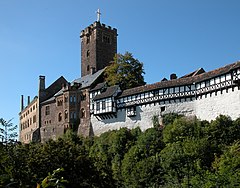Wartburg
| Wartburg Castle | |
|---|---|
| Wartburg | |

Wartburg in Eisenach
|
|
| Former names | Wartberg |
| General information | |
| Type | Castle |
| Town or city | Eisenach |
| Country | Germany |
| Coordinates | 50°57′58″N 10°18′23″E / 50.9662°N 10.3065°E |
| Construction started | c. 1067 |
| Renovated | 19th and 20th centuries |
| Landlord | Wartburg Stiftung |
| Official name | Wartburg Castle |
| Type | Cultural |
| Criteria | iii, vi |
| Designated | 1999 (23rd session) |
| Reference no. | 897 |
| Region | Europe and North America |
The Wartburg is a castle originally built in the Middle Ages. It is situated on a 410 meters (1,350 ft) precipice to the southwest of, and overlooking the town of Eisenach, in the state of Thuringia, Germany. In 1999, UNESCO added Wartburg Castle to the World Heritage List. It was the home of St. Elisabeth of Hungary, the place where Martin Luther translated the New Testament of the Bible into German, the site of the Wartburg festival of 1817 and the supposed setting for the legendary Sängerkrieg. It was an important inspiration for Ludwig II when he decided to build Neuschwanstein Castle. Wartburg is the most-visited tourist attraction in Thuringia after Weimar. Although the castle today still contains substantial original structures from the 12th through 15th centuries, much of the interior dates back only to the 19th century.
The name of the castle is probably derived from German: Warte, a watchtower, in spite of a tradition which holds that the castle's founder, on first laying eyes on the site, exclaimed, "Warte, Berg -- du sollst mir eine Burg tragen!" ("Wait, mountain -- you shall bear my castle!"). It is a German play on words for mountain (Berg) and fortress (Burg). In addition, Louis the Springer is said to have had clay from his lands transported to the top of the hill, which was not quite within his lands, so he might swear that the castle was built on his soil.
Wartburg is located on a 410 meters (1,350 ft) precipice to the southwest of, and overlooking the town of Eisenach, in the state of Thuringia, Germany. The hill is an extension of Thuringian Forest, overlooking Mariental to the south-east and the valley of the Hörsel to the north, through which passed the historical Via Regia. The Rennsteig passes not far to the south of the castle.
...
Wikipedia

